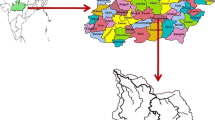Abstract
Water and soil are the most essential natural resources for socioeconomic development and sustenance of life. A study of soil and water dynamics at a watershed level facilitates a scientific approach towards their conservation and management. Remote sensing and Geographic Information System are tools that help to plan and manage natural resources on watershed basis. Studies were conducted for the formulation of catchment area treatment plan based on watershed prioritization with soil erosion studies using remote sensing techniques, corroborated with Geographic Information System (GIS), secondary data and ground truth information. Estimation of runoff and sediment yield is necessary in prioritization of catchment for the design of soil conservation structures and for identifying the critical erosion-prone areas of a catchment for implementation of best management plan with limited resources. The Universal Soil Loss Equation, Sediment Yield Determination and silt yield index methods are used for runoff and soil loss estimation for prioritization of the catchments. On the basis of soil erosion classes, the watersheds were grouped into very high, high, moderate and low priorities. High-priority watersheds need immediate attention for soil and water conservation, whereas low-priority watershed having good vegetative cover and low silt yield index may not need immediate attention for such treatments.







Similar content being viewed by others
References
David, W. P. (1988). Soil and water conservation planning: policy issues and recommendations. Journal of Philippine Development, 15(26), 47–84.
FAO (1977). Assessing soil degradation. A paper by Foster G.R. on Soil Degradation Assessment in the USA. FAO Soils Bulletin, 34(21), 25.
FAO (1985). Watershed development with special reference to soil and water conservation. Rome: FAO Soils Bulletin 44, p. 257.
FAO (1987). FAO (1987). Soil and water conservation in semi-and areas, Hudson, N.W. (p. 185). Rome, Italy: FAO Soils Bulletin No. 57, p. 85.
Glover, J. (1984). Landsat feasibility study—Oklawaha basin. Palatka, Fla: Prepared for the St. Johns River Water Management District.
Honore, G. (1999). Our land, ourselves-guide to watershed management in India. New Delhi: Government of India. 238 p.
Johnson, L. E. (1989). A digital map based hydrologic modeling system. Photogrammetric Engineering and Remote Sensing, 55(6), 911–917.
Khan, M. A. (1999). Water balance and hydrochemistry of precipitation components in forested ecosystem in the arid zone of Rajasthan, India. Hydrological Science Journal, 44, 149–161.
Kouwen, N., Soulis, E. D., Pietroniro, A., Donald, J., & Harrington, R. A. (1993). Grouped response units for distributed hydrologic modeling. Journal of Water Resources Planning and Management, ASCE, 119(3), 289–305.
Manyatsi, A. M. (1997). Procedure for assessing land degradation status in Swaziland using remotely sensed data, University of Swaziland. Journal of Agriculture, 6(1997), 21–35.
Moore, I. D., Grayson, R. B., & Ladson, A. R. (1994). Digital terrain modeling. In K. J. Beven & I. D. Moore (Eds.), A review of hydrological, geomorphological and biological application (pp. 7–31). Chichester: Wiley. 249 pp.
Pierce, F. J., Larson, W. E., & Dowdy, R. H. (1986). Soil conservation: an assessment of the national resources inventory (Vol. 2). Washington, D.C.: National Academy Press.
Rao, Y.P. (1981) Evaluation of cropping management factor in universal soil Loss equation under natural rainfall condition of kharagpur, India. In Proceedings of Southeast Asian regional symposium on problems of soil erosion and sedimentation. Bangkok: Asian Institute of Tedchnology, pp. 241–254.
Renard, K. G., Foster, G. R., Weesies, G. A., McCool, D. K., & Yoder, D. C. (1997). Predicting soil erosion by water: a guide to conservation planning with the Revised Universal Soil Loss Equation (RUSLE), US Department of Agriculture, Agricultural Handbook Number vol. 703. Washington, D.C.: GPO.
Ross, M. A., & Tara, P. D. (1993). Integrated hydrologic modeling with geographic information systems. Journal of Water Resources Planning and Management, ASCE, 119(2), 129–140.
Tideman, E. M. (1996). Watershed management, guidelines for Indian conditions. New Delhi: Omega Scientific Publishers. 372 p.
Tripathi, R. P., & Singh, H. P. (1993). Soil erosion conservation. India: Wiley Eastern Limited.
USDA-SCS (1972). Hydrology Guide for Use in Watershed Planning. SCS National Engineering Handbook, Section 4: Hydrology, Supplement A. Washington, D.C.: U.S. Department of Agriculture, Soil Conservation Service.
Williams, J. R., & Berndt, H. D. (1972). Sediment yield computed with universal equation. Journal of Hydraulics Division, ASCE, 98(HY2), 2087–2098.
Wischmeier, W. H., & Smith, D. D. (1978). Predicting rainfall erosion losses. USDA agricultural research services handbook 537 (p. 57). Washington, D.C.: USDA.
Young, R. A., Onstad, C. A., Bosch, D. D., and Anderson, W. P. (1987). AGNPS, Agricultural non-point source pollution model: A watershed analysis tool. Springfield, Va: U.S. Dept. of Commerce, National Technical Information Service.
Author information
Authors and Affiliations
Corresponding author
Rights and permissions
About this article
Cite this article
Khadse, G.K., Vijay, R. & Labhasetwar, P.K. Prioritization of catchments based on soil erosion using remote sensing and GIS. Environ Monit Assess 187, 333 (2015). https://doi.org/10.1007/s10661-015-4545-z
Received:
Accepted:
Published:
DOI: https://doi.org/10.1007/s10661-015-4545-z




